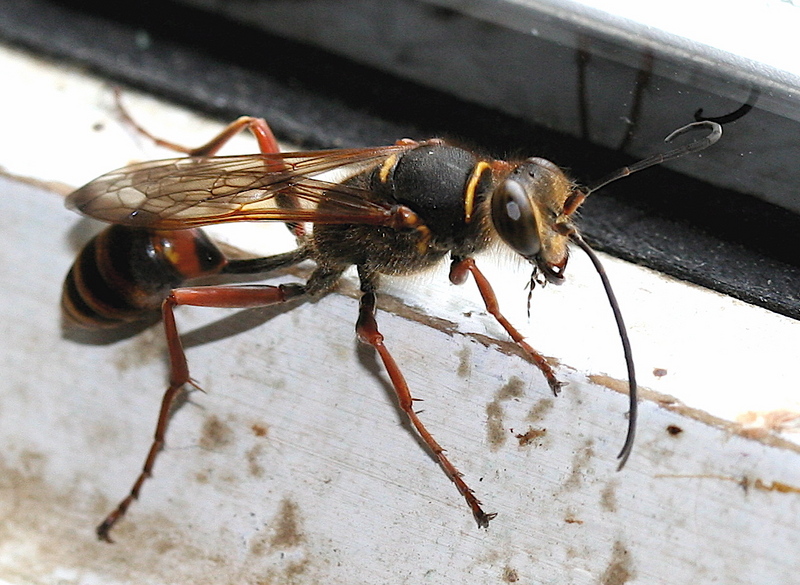|
| Query: Black cuckoo | Result: 89th of 90 | |
Mud Dauber (Family: Sphecidae, Genus: Sceliphron) - Wiki
| Subject: | Mud Dauber (Family: Sphecidae, Genus: Sceliphron) - Wiki
| |

| Resolution: 1151x841
File Size: 442309 Bytes
Date: 2006:06:22 14:22:56
Camera: Canon EOS 350D DIGITAL (Canon)
F number: f/7.1
Exposure: 1/200 sec
Focal Length: 60/1
Upload Date: 2007:09:13 11:42:33
|
Sceliphron
From Wikipedia, the free encyclopedia
[Photo] Hymenoptera - Sphecidae - Sceliphron curvatum (Smith, 1870). Date June 22, 2006. Rh??ne, France. Author IronChris (http://commons.wikimedia.org/wiki/User:IronChris)
Sceliphron is a genus of Hymenoptera of the Sphecidae family, commonly referred to as mud daubers. They are solitary and build nests made of mud. Nests are frequently constructed in shaded niches, often just inside of windows or vent openings, and it may take a female only a day to construct a cell requiring dozens of trips carrying mud. Females will add new cells one by one to the nest after each cell is provisioned. They provision these nests with spiders, such as crab spiders, orb-weaver spiders and jumping spiders in particular, as food for the developing larvae. Each mud cell contains one egg and is provided with several prey items. Females of some species lay a modest average of 15 eggs over their whole lifespan. Various parasites attack these nests, including several species of cuckoo wasps, primarily by sneaking into the nest while the resident mud dauber is out foraging.
As is the case with many insect genera, there are many tropical species. Some common temperate species include the black and yellow mud dauber (Sceliphron caementarium) and Sceliphron curvatum.
Like other solitary wasps, Sceliphron species are not aggressive and do not sting unless mishandled. They are sometimes regarded as beneficial due to their control of spider populations, though the spiders themselves may be beneficial in controlling pest insects. Species such as Sceliphron curvatum are invasive in some parts of Europe, where they have been observed to rapidly increase their range in recent years.
Sceliphron species
Sceliphron Klug 1801
Sceliphron spirifex Linnaeus 1758 (Sphex); Africa, southern Europe
Sceliphron asiaticum Linnaeus 1758 (Sphex); Neotropics. Type locality In Indiis was interpreted as India; syn. S. figulum
Sceliphron caementarium Drury 1773 (Sphex). North America, established in Europe and Pacific islands by the 1970's
Sceliphron jamaicense Fabricius 1775; Mexico, Caribbean islands
Sceliphron madraspatanum Fabricius 1781; Mediterranean
Sceliphron (m.) tubifex Latreille 1809; Mediterranean
Sceliphron destillatorium Illiger 1807; southern Palaearctic
Sceliphron assimile Dahlbom 1843 (Pelopoeus); Texas, Mexico and Caribbean islands
Sceliphron fistularium Dahlbom 1843; Neotropics
Sceliphron javanum Lepeletier 1845
Sceliphron coromandelicum Lepeletier 1845
Sceliphron chilensis Spinola 1851
Sceliphron laetum Smith 1856; Australia
Sceliphron formosum Smith 1856; Australia
Sceliphron deforme Smith 1856; Asia, reported from Europe in 2004
Sceliphron benignum Smith 1859
Sceliphron curvatum Smith 1870; Asia, Europe since 1970’s
Sceliphron quartinae Gribodo 1884
Sceliphron imflexum Sickmann 1894
Sceliphron nalandicum Strand 1915
Sceliphron argentifrons Cresson 1916
Sceliphron bugabense Dalla Torre 1897
Sceliphron cyclocephalum Dalla Torre 1897
Sceliphron intermedium Dalla Torre 1897
Sceliphron rufiventre Dalla Torre 1897
Sceliphron abdominale Dalla Torre 1897
Sceliphron soror Dalla Torre 1897
Sceliphron caucasicum Dalla Torre 1897
http://en.wikipedia.org/wiki/Sceliphron
| The text in this page is based on the copyrighted Wikipedia article shown in above URL. It is used under the GNU Free Documentation License. You may redistribute it, verbatim or modified, providing that you comply with the terms of the GFDL. |
|
^o^
Animal Pictures Archive for smart phones
^o^
|
|

